Tectonic Uplift and Hydrocarbon Generation Constraints from Low-Temperature Thermochronology in the Yindongzi Area, Ordos Basin
Abstract
1. Introduction
2. Geological Setting
3. Sampling Strategy and Methodology
3.1. Sampling
3.2. AFT Analysis
3.3. (U-Th)/He Analysis
3.4. Thermal History Modeling
3.5. Burial History Reconstruction
4. Results
4.1. Low-Temperature Thermochronology Results
4.2. Thermal History Modeling
5. Discussion
5.1. Uplift and Exhumation History of the Study Area
5.1.1. Paleozoic History Revealed by ZHe Ages
5.1.2. Mesozoic Differential Uplift and the Role of Faulting
5.1.3. Cenozoic Rejuvenation: Effects of Far-Field Himalayan Tectonics
5.2. Tectonic Evolution and Stress Regimes
5.2.1. Paleozoic: Deep Burial and Early Basin Development
5.2.2. Mesozoic: Regional Uplift and Reactivation of Fault Systems
5.2.3. Cenozoic: Reactivation and Far-Field Response to Himalayan Tectonics
5.3. Burial and Uplift History: Constraints on Hydrocarbon Generation and Accumulation
6. Conclusions
- (1)
- Thermochronological and thermal modeling results from the study area reveal a complex, multi-stage exhumation history strongly influenced by both local fault systems and regional geodynamic processes. The ages reflect early deep burial and thermal events associated with Variscan and Qinling–Qilian tectonism. During the Mesozoic, the Yanshanian Orogeny triggered fault reactivation and differential uplift, with the western fault block (YT1) exhuming earlier and more rapidly than the eastern block (YT2, YT3), forming a pattern of tectonic uplift propagating from the basin margin toward the interior. In the Cenozoic, renewed exhumation and rapid cooling, especially after the Early Miocene, correlate with the far-field compressional effects of the Himalayan Orogeny and the uplift of the Tibetan Plateau. The fault system served as a conduit for stress transmission and a key control on the timing and rate of exhumation.
- (2)
- Thermal history reconstruction indicates that the study area reached its maximum burial and thermal maturity during the Late Jurassic, followed by a phase of significant exhumation. This timing coincides with the peak hydrocarbon generation for both Paleozoic and Mesozoic source rocks. However, the subsequent uplift and erosion—initiated in the Late Jurassic and intensified during later tectonic phases—led to the partial destruction of source rock continuity, deterioration of burial conditions, and potential hydrocarbon loss. Spatial variations in uplift intensity further resulted in uneven maturation levels and hydrocarbon generation capacity across different fault blocks. In the Yindongzi area, strong thrust-related uplift during the Yanshanian deformation inhibited source rock maturation, as evidenced by relatively low vitrinite reflectance values in some wells.
Author Contributions
Funding
Data Availability Statement
Conflicts of Interest
References
- Xi, S.; Mo, W.; Liu, X.; Zhang, L.; Li, J.; Huang, Z.; Wang, M.; Zhang, C.; Zhu, Q.; Yan, Y.; et al. Shale gas exploration potential of the Ordovician Wulalike Formation in the western margin of the Ordos Basin: A case study of Zhongping 1 Well. Nat. Gas Geosci. 2021, 32, 1235–1246. [Google Scholar]
- Xing, G.Y.; Ren, Z.L.; Qi, K.; Guo, S.S.; Liu, Y.Z. Low-temperature thermochronologic analysis and geologic significance of the northern part of the western margin of the Ordos Basin: A case study of the Moergou profile in the Zhuozishan area, Inner Mongolia, China. Geol. J. 2024, 60, 871–882. [Google Scholar]
- Kapp, P.; DeCelles, P.G.; Gehrels, G.E.; Heizler, M.; Ding, L. Geological records of the lhasa-qiangtang and indo-asian collisions in the Nima area of central Tibet. Geol. Soc. Am. Bull. 2007, 119, 917–933. [Google Scholar] [CrossRef]
- Ren, Z.L.; Tian, T.; Li, J.B.; Wang, J.P.; Cui, J.P.; Li, H.; Tang, J.Y.; Guo, K. Research methods for thermal evolution history of sedimentary basins and progress in reconstructing thermal evolution history of overlapping basins. J. Earth Sci. Environ. 2014, 36, 1–20. [Google Scholar]
- Peng, H.; Wang, J.Q.; Liu, C.Y.; Zhang, S.H.; Zattin, M.; Wu, N.; Feng, Q. Thermochronological constraints on the Meso-Cenozoic tectonic evolution of the Haiyuan–Liupanshan region, northeastern Tibetan Plateau. J. Asian Earth Sci. 2019, 183, 103966. [Google Scholar] [CrossRef]
- Peng, H.; Wang, J.; Liu, C.; Zhao, H.; Huang, L.; Zhao, X.; Zhang, S.; Liang, C.; Wang, Z.; Catto, S.; et al. Long-term and multiple stage exhumation of the Ordos Basin, western North China Craton: Insights from seismic reflection, borehole and geochronological data. Earth-Sci. Rev. 2023, 238, 104349. [Google Scholar] [CrossRef]
- Sweeney, J.J.; Burnham, A.K. Evaluation of a simple model of vitrinite reflectance based on chemical kinetics. AAPG Bull. 1990, 74, 1559–1570. [Google Scholar] [CrossRef]
- Ren, Z.L. Study on the geothermal history of the Ordos Basin using the apatite fission track method. Chin. J. Geophys. 1995, 38, 339–349. [Google Scholar]
- Ren, Z.L.; Zhang, S.; Gao, S.L.; Cui, J.P.; Xiao, Y.Y.; Xiao, H. Tectonic thermal evolution history of the Ordos Basin and its significance for accumulation and mineralization. Sci. China Ser. D Earth Sci. 2007, 9, 23–32. [Google Scholar]
- Ren, Z.L.; Qi, K.; Liu, R.C.; Cui, J.P.; Chen, Z.P.; Zhang, Y.Y.; Yang, G.L.; Ma, Q. The dynamical background of Early Cretaceous tectonic thermal events in the Ordos Basin and their control on the accumulation periods of various minerals, including oil and gas. Acta Petrol. Sin. 2020, 36, 1213–1234. [Google Scholar]
- Ren, Z.L.; Cui, J.P.; Qi, K.; Yang, P.; Liu, X.S.; Zhang, C.L.; Yang, G.L.; Gao, Y.F.; Zhang, Y.; Xing, G.Y. New advances in the theoretical research and methods for restoring the thermal evolution history of deep and ultra-deep layers in overlapping basins. J. Northwest Univ. (Nat. Sci. Ed.) 2022, 52, 910–929. [Google Scholar]
- Ketcham, R.A. Forward and inverse modeling of low-temperature thermochronometry data. Rev. Mineral. Geochem. 2005, 58, 275–314. [Google Scholar] [CrossRef]
- Hasebe, N.; Barbarand, J.; Jarvis, K.; Carter, A.; Hurford, A.J. Apatite fission-track chronometry using laser ablation ICP-MS. Chem. Geol. 2004, 207, 135–145. [Google Scholar] [CrossRef]
- Dunkl, I. Trackkey: A Windows program for calculation and graphical presentation of fission track data. Comput. Geosci. 2002, 28, 3–12. [Google Scholar] [CrossRef]
- Flowers, R.M.; Farley, K.A.; Ketcham, R.A. A reporting protocol for thermochronologic modeling illustrated with data from the Grand Canyon. Earth Planet. Sci. Lett. 2015, 432, 425–435. [Google Scholar] [CrossRef]
- Vermeesch, P. RadialPlotter: A Java application for fission track, luminescence and other radial plots. Radiat. Meas. 2009, 44, 409–410. [Google Scholar] [CrossRef]
- Zhao, H.G.; Liu, C.Y.; Yao, Y.M.; Wang, F.; Yin, Y. Fission track evidence of differential uplift in the western Ordos Basin. J. Northwest Univ. (Nat. Sci. Ed.) 2007, 3, 470–474. [Google Scholar]
- Vassallo, R.; Jolivet, M.; Ritz, J.-F.; Braucher, R.; Larroque, C.; Sue, C.; Todbileg, M.; Javkhlanbold, D. Uplift age and rates of the Gurvan Bogd system (Gobi-Altay) by apatite fission track analysis. Earth Planet. Sci. Lett. 2007, 259, 333–346. [Google Scholar] [CrossRef]
- Donelick, R.A.; O’Sullivan, P.B.; Ketcham, R.A. Apatite fission-track analysis. Rev. Mineral. Geochem. 2005, 58, 49–94. [Google Scholar] [CrossRef]
- Farley, K.A.; Wolf, R.A.; Silver, L.T. The effects of long alpha-stopping distances on (U-Th)/He ages. Geochim. Cosmochim. Acta 1996, 60, 4223–4229. [Google Scholar] [CrossRef]
- Ketcham, R.A.; Carter, A.; Donelick, R.A.; Barbarand, J.; Hurford, A.J. Improved modeling of fission-track annealing in apatite. Am. Mineral. 2007, 92, 799–810. [Google Scholar] [CrossRef]
- Carlson, W.D.; Donelick, R.A.; Ketcham, R.A. Variability of apatite fission-track annealing kinetics: I. Experimental results. Am. Mineral. 1999, 84, 1213–1223. [Google Scholar] [CrossRef]
- Barbarand, J.; Carter, A.; Wood, I.; Hurford, T. Compositional and structural control of fission-track annealing in apatite. Chem. Geol. 2003, 198, 107–137. [Google Scholar] [CrossRef]
- Gautheron, C.; Tassan-Got, L.; Barbarand, J.; Pagel, M. Effect of alpha-damage annealing on apatite (U–Th)/He thermochronology. Chem. Geol. 2009, 266, 157–170. [Google Scholar] [CrossRef]
- George, A.D.; Marshallsea, S.J.; Wyrwoll, K.-H.; Jie, C.; Yanchou, L. Miocene cooling in the northern Qilian Shan, northeastern margin of the Tibetan Plateau, revealed by apatite fission-track and vitrinite-reflectance analysis. Geology 2001, 29, 939–942. [Google Scholar] [CrossRef]
- Gleadow, A.; Duddy, I.; Green, P.F.; Lovering, J. Confined fission track lengths in apatite: A diagnostic tool for thermal history analysis. Contr. Miner. Petrol. 1986, 94, 405–415. [Google Scholar] [CrossRef]
- Gleadow, A.; Duddy, I.; Lovering, J. Fission track analysis: A new tool for the evaluation of thermal histories hydrocarbon potential. APPEA J. 1983, 23, 93–102. [Google Scholar] [CrossRef]
- Laslett, G.; Green, P.F.; Duddy, I.; Gleadow, A. Thermal annealing of fission tracks in apatite 2. A quantitative analysis. Chem. Geol. Isot. Geosci. Sect. 1987, 65, 1–13. [Google Scholar] [CrossRef]
- Hurford, A.J. Standardization of fission track dating calibration: Recommendation by the Fission Track Working Group of the IUGS Subcommission on Geochronology. Chem. Geol. Isot. Geosci. Sect. 1990, 80, 171–178. [Google Scholar] [CrossRef]
- Hurford, A.J.; Green, P.F. The zeta age calibration of fission-track dating. Chem. Geol. 1983, 41, 285–317. [Google Scholar] [CrossRef]
- Perotti, M.; Andreucci, B.; Talarico, F.; Zattin, M.; Langone, A. Multianalytical provenance analysis of Eastern Ross Sea LGM till sediments (Antarctica): Petrography, geochronology, and thermochronology detrital data. Geochem. Geophys Geosyst. 2017, 18, 2275–2304. [Google Scholar] [CrossRef]
- Peng, H.; Ding, L.; Liu, C.Y.; Zattin, M.; Wang, L.C. Middle Triassic transcontinental connection between the North China Craton and the Paleo-Tethys Ocean. Commun. Earth Environ. 2024, 5, 775. [Google Scholar] [CrossRef]
- Wang, W.; Zhao, Y.; Liu, X.C.; Hu, J.M.; Wei, C.J.; Xiao, W.J.; Du, J.X.; Wang, S.L.; Zhan, L.Q. Metamorphism of diverse basement gneisses of the Ordos Basin: Record of multistage Paleoproterozoic orogenesis and constraints on the evolution of the western North China Craton. Precambrian Res. 2019, 328, 48–63. [Google Scholar] [CrossRef]
- Darby, B.J.; Ritts, B.D. Mesozoic contractional deformation in the middle of the Asian tectonic collage: The intraplate Western Ordos fold–thrust belt, China. Earth Planet. Sci. Lett. 2002, 205, 13–24. [Google Scholar] [CrossRef]
- Sun, J.P.; Dong, Y.P.; Zhao, J.F.; Chen, Q. Carboniferous to Triassic polyphase tectonic transition in the western North China craton: A retroarc basin response to termination of the middle segment of the Paleo-Asian Ocean. Geol. Soc. Am. Bull. 2024, 136, 4149–4174. [Google Scholar] [CrossRef]
- Faure, M.; Lin, W.; Chen, Y. Is the Jurassic (Yanshanian) intraplate tectonics of North China due to westward indentation of the North China block? Terra Nova 2012, 24, 456–466. [Google Scholar] [CrossRef]
- Gallagher, K. Transdimensional inverse thermal history modeling for quantitative thermochronology. J. Geophys. Res. Solid Earth 2012, 117, B02401. [Google Scholar] [CrossRef]
- Darby, B.J.; Ritts, B.D. Mesozoic structural architecture of the Lang Shan, North-Central China: Intraplate contraction, extension, and synorogenic sedimentation. J. Struct. Geol. 2007, 29, 2006–2016. [Google Scholar] [CrossRef]
- Liu, S.F. The coupling mechanism of basin and orogen in the western Ordos Basin and adjacent regions of China. J. Asian Earth Sci. 1998, 16, 369–383. [Google Scholar] [CrossRef]
- Zhang, J.; Yun, L.; Zhang, B.H.; Qu, J.F.; Zhao, H.; Hui, J.; Wang, Y.N.; Zhang, Y.P. Deformation at the easternmost Altyn Tagh Fault: Constraints on the growth of the northern Qinghai–Tibetan Plateau. Acta Geol. Sin. (Engl. Ed.) 2020, 94, 988–1006. [Google Scholar] [CrossRef]
- Wang, T.; Guo, L.; Zheng, Y.; Donskaya, T.; Gladkochub, D.; Zeng, L.; Li, J.; Wang, Y.; Mazukabzov, A. Timing and processes of late Mesozoic mid–lower-crustal extension in continental NE Asia and implications for the tectonic setting of the destruction of the North China Craton: Mainly constrained by zircon U–Pb ages from metamorphic core complexes. Lithos 2012, 154, 315–345. [Google Scholar] [CrossRef]
- Zhang, J.; Wang, Y.N.; Qu, J.F.; Zhang, B.H.; Zhao, H.; Yun, L. Mesozoic intracontinental deformation of the Alxa Block in the middle part of Central Asian Orogenic Belt: A review. Int. Geol. Rev. 2021, 63, 1490–1520. [Google Scholar] [CrossRef]
- Zhang, J.; Cunningham, D.; Qu, J.F.; Zhang, B.H.; Li, J.Y.; Zhao, H.; Niu, P.F.; Hui, J.; Yun, L.; Zhao, S.; et al. Poly-phase structural evolution of the northeastern Alxa Block, China: Constraining the Paleozoic–Recent history of the southern Central Asian Orogenic Belt. Gondwana Res. 2022, 105, 25–50. [Google Scholar] [CrossRef]
- Duvall, A.R.; Clark, M.K.; Kirby, E.; Farley, K.A.; Craddock, W.H.; Li, C.; Yuan, D.Y. Low-temperature thermochronometry along the Kunlun and Haiyuan Faults, NE Tibetan Plateau: Evidence for kinematic change during late-stage orogenesis. Tectonics 2013, 32, 1190–1211. [Google Scholar] [CrossRef]
- England, P.; Molnar, P. Right-lateral shear and rotation as the explanation for strike-slip faulting in eastern Tibet. Nature 1990, 344, 140. [Google Scholar] [CrossRef]
- Gehrels, G.E.; Yin, A.; Wang, X.-F. Magmatic history of the northeastern Tibetan Plateau. J. Geophys. Res. Solid Earth 2003, 108. [Google Scholar] [CrossRef]
- Craddock, W.; Kirby, E.; Zhang, H.P. Late Miocene-Pliocene range growth in the interior of the northeastern Tibetan Plateau. Lithosphere 2011, 3, 420–438. [Google Scholar] [CrossRef]
- England, P.; Houseman, G. Finite strain calculations of continental deformation: Comparison with the India-Asia collision zone. J. Geophys. Res. Solid Earth 1986, 91, 3664–3676. [Google Scholar] [CrossRef]
- Tapponnier, P.; Peltzer, G.; Le Dain, A.Y.; Armijo, R.; Cobbold, P. Propagating extrusion tectonics in Asia: New insights from simple experiments with plasticine. Geology 1982, 10, 611–616. [Google Scholar] [CrossRef]
- Tapponnier, P.; Zhiqin, X.; Roger, F.; Meyer, B.; Arnaud, N.; Wittlinger, G.; Jingsui, Y. Oblique stepwise rise and growth of the Tibet Plateau. Science 2001, 294, 1671–1677. [Google Scholar] [CrossRef]
- Lease, R.O.; Burbank, D.W.; Hough, B.; Wang, Z.C.; Yuan, D.Y. Pulsed Miocene range growth in northeastern Tibet: Insights from Xunhua Basin magnetostratigraphy and provenance. GSA Bull. 2012, 124, 657–677. [Google Scholar] [CrossRef]
- Lease, R.O.; Burbank, D.W.; Clark, M.K.; Farley, K.A.; Zheng, D.W.; Zhang, H.P. Middle Miocene reorganization of deformation along the northeastern Tibetan Plateau. Geology 2011, 39, 359–362. [Google Scholar] [CrossRef]
- Bernet, M.; Garver, J.I. Fission-track analysis of detrital zircon. Rev. Mineral. Geochem. 2005, 58, 205–237. [Google Scholar] [CrossRef]
- Bernet, M.; Van Der Beek, P.; Pik, R.; Huyghe, P.; Mugnier, J.; Labrin, E.; Szulc, A. Miocene to Recent exhumation of the central Himalaya determined from combined detrital zircon fission-track and U/Pb analysis of Siwalik sediments, western Nepal. Basin Res. 2006, 18, 393–412. [Google Scholar] [CrossRef]
- Bertrand, A.; Rosenberg, C.; Rabaute, A.; Herman, F.; Fügenschuh, B. Exhumation mechanisms of the Tauern Window (Eastern Alps) inferred from apatite and zircon fission track thermochronology. Tectonics 2017, 36, 207–228. [Google Scholar] [CrossRef]
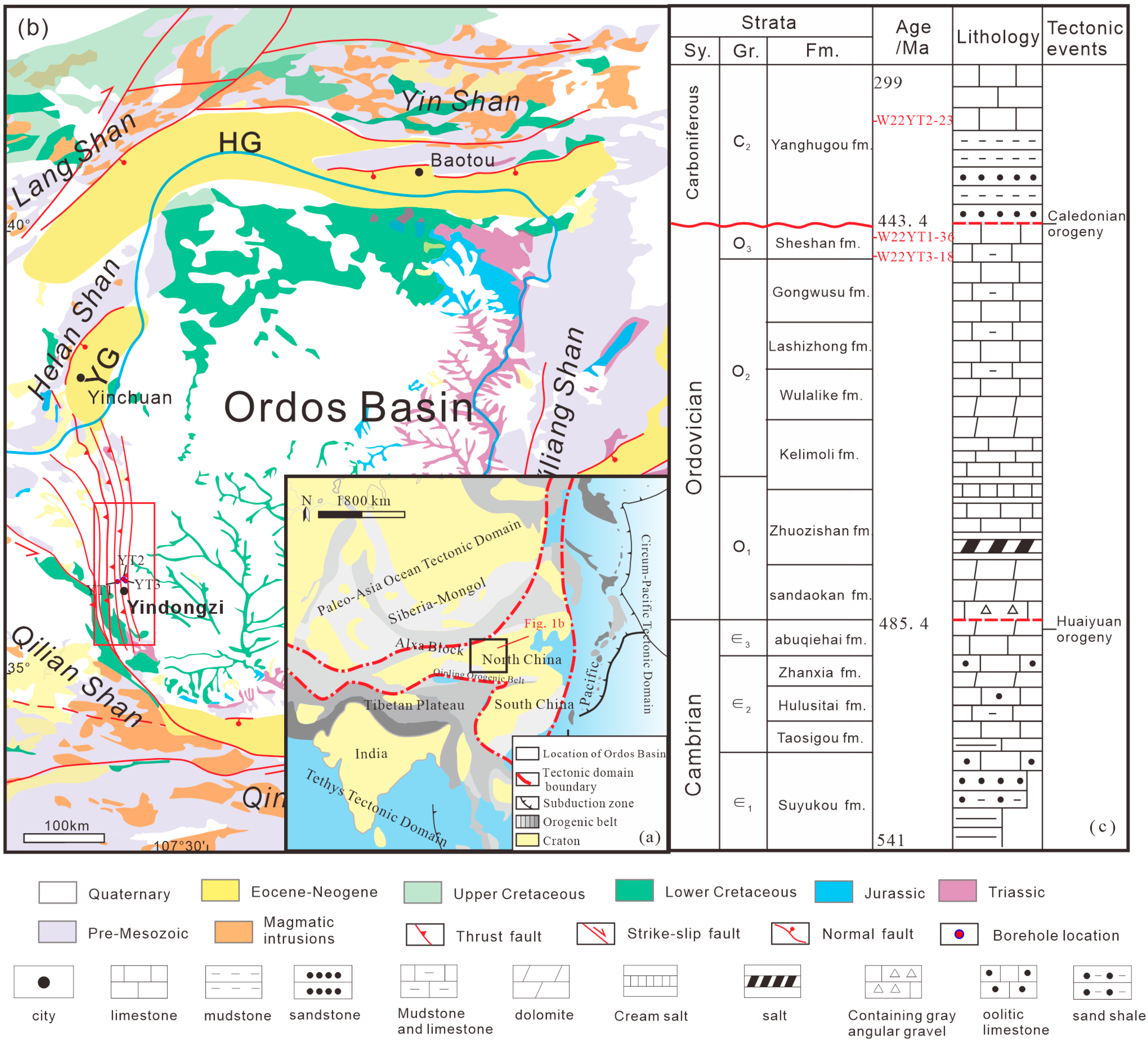
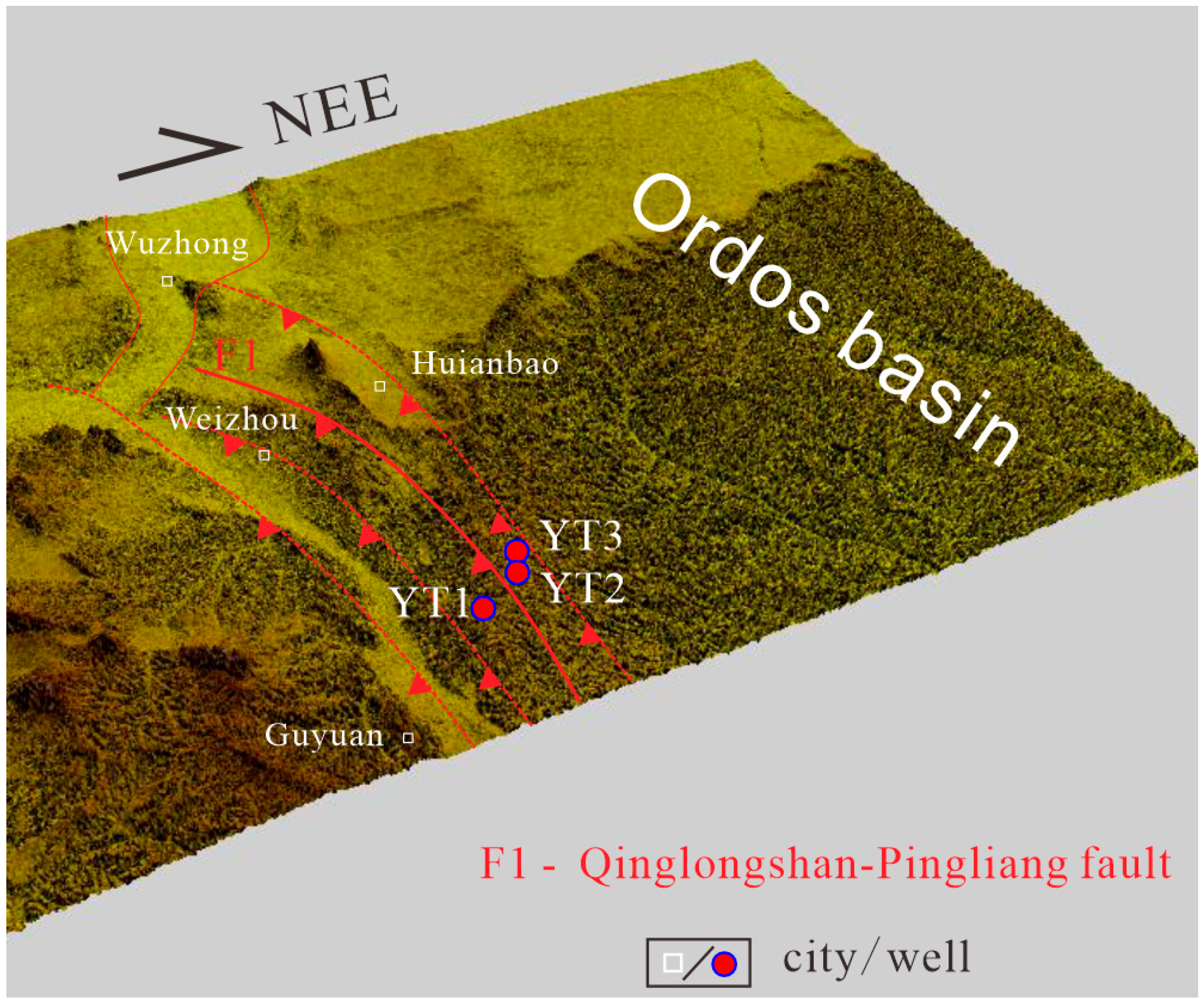

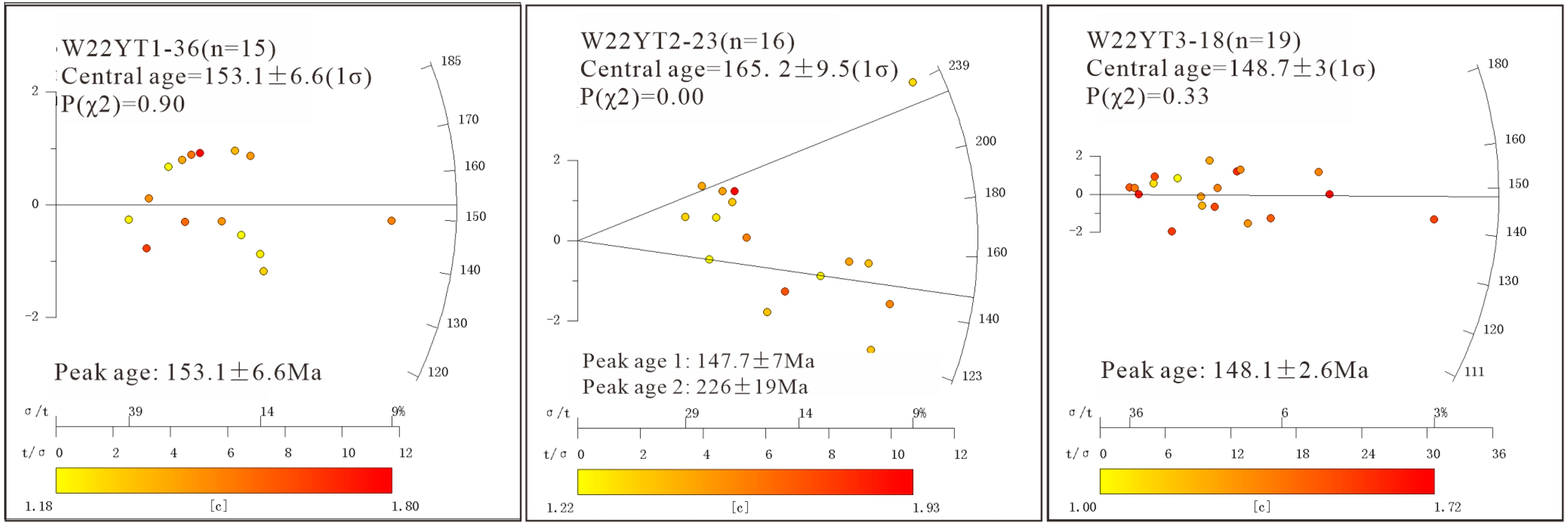
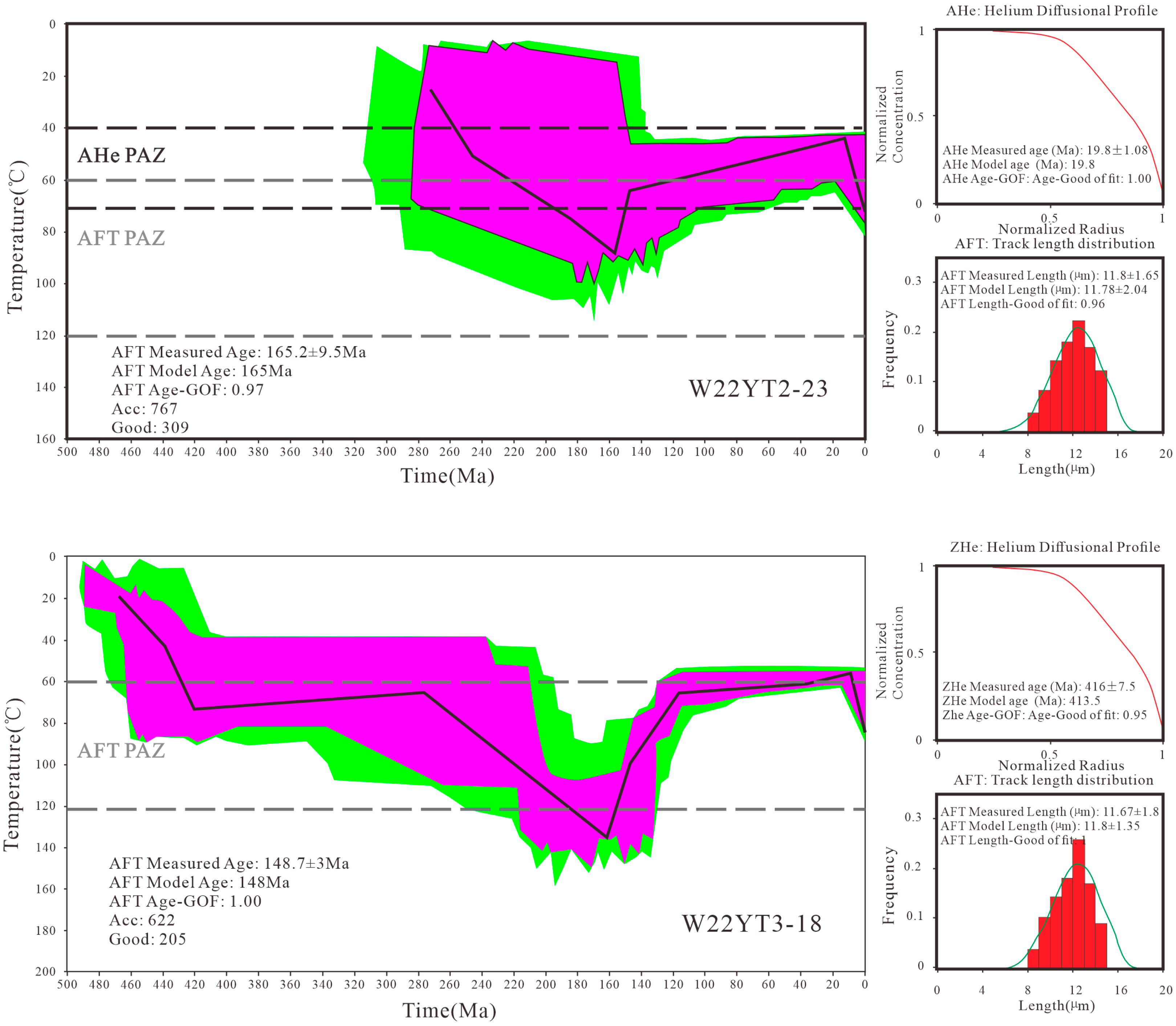
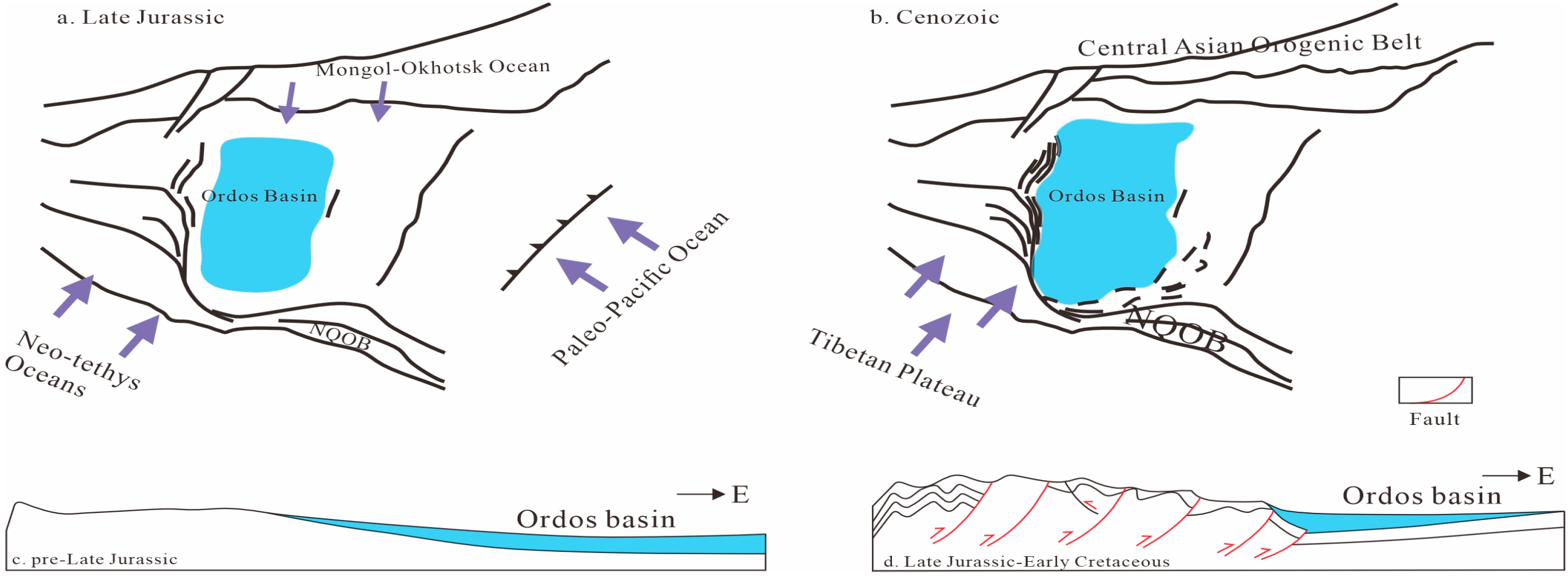
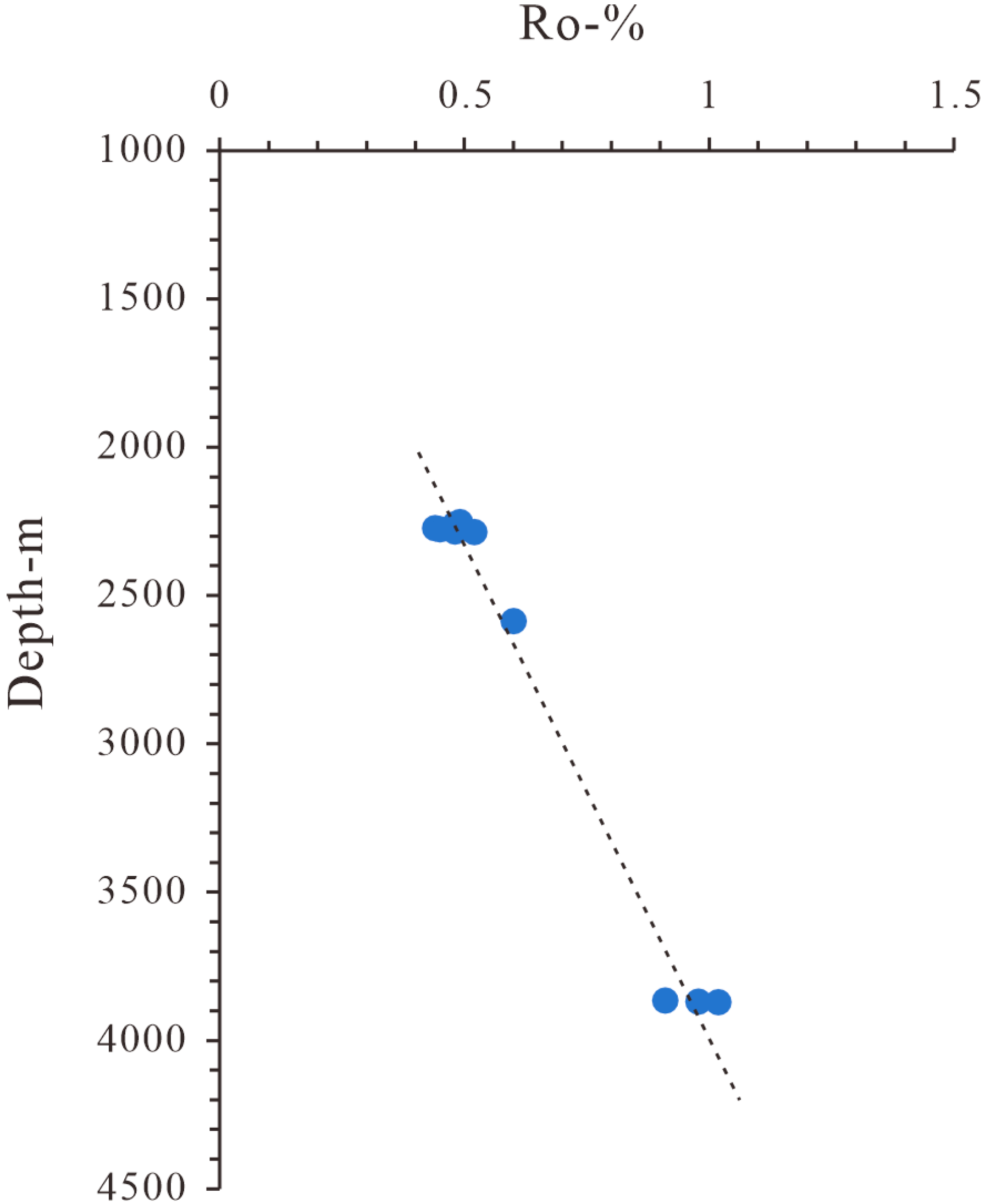
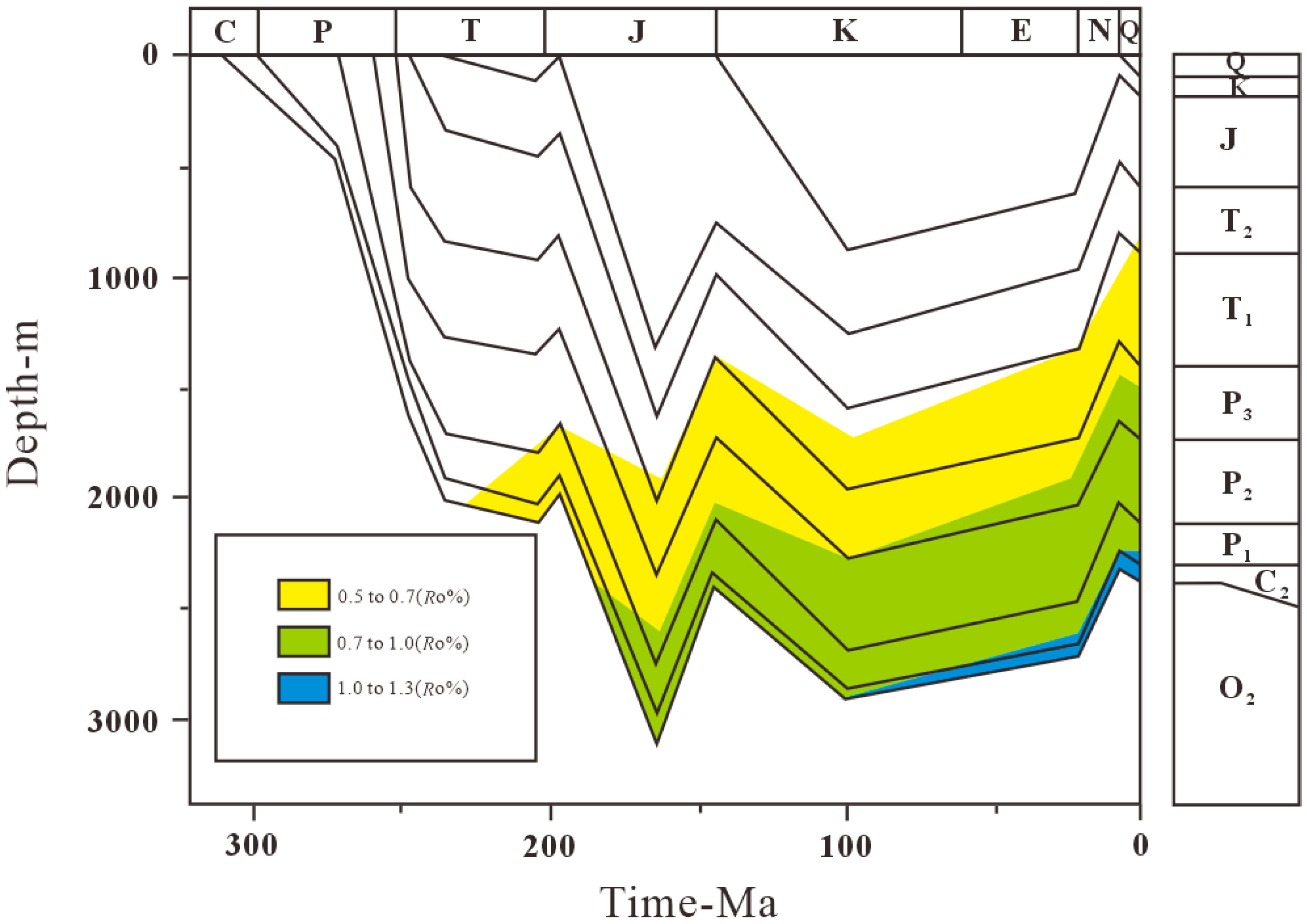
| Sample NO. | Well of Samples | Formation | Lithology | Depth (m) | Methods |
|---|---|---|---|---|---|
| W22YT1-36 | YT1 | O3 | Sandstone | 1206 | AFT, Ahe, ZHe |
| W22YT2-23 | YT2 | C2 | Sandstone | 2572.5 | AFT, Ahe, ZHe |
| W22YT3-18 | YT3 | O3 | Sandstone | 2310 | AFT, ZHe |
| Sample | n | Ns | Ρs (×106/cm2) | 238U(×10−6) | Central age(Ma) | P(χ2) (%) | MTL(μm) (N) | Dpar (μm) |
|---|---|---|---|---|---|---|---|---|
| W22YT1-36 | 15 | 468 | 2.78 | 37.89 ± 8.52 | 153.1 ± 6.6 | 90 | 1.42 ± 0.18 | |
| W22YT2-23 | 16 | 561 | 1.49 | 23.33 ± 6.64 | 165.2 ± 9.5 | 0 | 12.09 ± 1.84(96) | 1.46 ± 0.18 |
| W22YT3-18 | 19 | 1451 | 2.02 | 38.69 ± 4.64 | 148.7 ± 3 | 33 | 11.63 ± 1.02(89) | 1.41 ± 0.19 |
| Sample | Mass (ug) | Rs (um) | U (ppm) | Th (ppm) | Th/U | [eU] (ppm) | mol 4He | Std. mol 4He | FT | Cor Age (Ma) | ±σ (Ma) |
|---|---|---|---|---|---|---|---|---|---|---|---|
| W22YT1-36-A1 | 2.16 | 45.8 | 6.6 | 14.3 | 2.2 | 10.0 | 2.4595 × 10−15 | 3.2348 × 10−17 | 0.698 | 30.32 | 1.66 |
| W22YT1-36-A2 | 1.52 | 39.7 | 48.6 | 24.9 | 0.5 | 54.5 | 2.4486 × 10−14 | 3.0208 × 10−16 | 0.667 | 82.38 | 4.40 |
| W22YT1-36-A3 | 1.49 | 40.1 | 5.4 | 16.3 | 3.1 | 9.2 | 3.3023 × 10−16 | 7.3221 × 10−18 | 0.656 | 6.80 | 0.39 |
| W22YT1-36-A4 | 0.95 | 34.0 | 33.5 | 48.5 | 1.5 | 44.9 | 8.9168 × 10−15 | 1.0279 × 10−16 | 0.609 | 63.78 | 3.37 |
| W22YT2-23-A1 | 5.92 | 63.0 | 8.9 | 18.3 | 2.1 | 13.2 | 6.4588 × 10−15 | 8.3110 × 10−17 | 0.775 | 19.78 | 1.08 |
| W22YT2-23-A2 | 3.73 | 53.8 | 18.2 | 57.2 | 3.2 | 31.7 | 1.1963 × 10−14 | 1.3943 × 10−16 | 0.735 | 25.54 | 1.34 |
| W22YT2-23-A3 | 4.55 | 56.6 | 11.9 | 39.4 | 3.4 | 21.1 | 3.9245 × 10−16 | 1.0533 × 10−17 | 0.746 | 1.02 | 0.06 |
| Sample | Mass (ug) | Rs (um) | U (ppm) | Th (ppm) | Th/U | [eU] (ppm) | mol 4He | Std. mol 4He | FT | Cor Age (Ma) | ±σ (Ma) |
|---|---|---|---|---|---|---|---|---|---|---|---|
| W22YT1-36-Z1 | 3.12 | 49.1 | 134.8 | 67.8 | 0.5 | 150.7 | 6.5955 × 10−13 | 8.0422 × 10−15 | 0.766 | 334.37 | 17.96 |
| W22YT1-36-Z2 | 3.32 | 45.1 | 595.3 | 121.1 | 0.2 | 623.8 | 3.1607 × 10−12 | 3.3923 × 10−14 | 0.753 | 369.39 | 19.54 |
| W22YT1-36-Z3 | 5.05 | 48.3 | 265.1 | 135.9 | 0.5 | 297.0 | 2.4956 × 10−12 | 3.0324 × 10−14 | 0.768 | 393.98 | 20.86 |
| W22YT1-36-Z4 | 5.31 | 55.5 | 212.7 | 187.5 | 0.9 | 256.8 | 1.8997 × 10−12 | 2.3433 × 10−14 | 0.791 | 321.72 | 16.97 |
| W22YT2-23-Z1 | 3.02 | 41.7 | 141.9 | 128.5 | 0.9 | 172.1 | 1.5036 × 10−12 | 1.8233 × 10−14 | 0.728 | 710.40 | 37.65 |
| W22YT2-23-Z2 | 5.12 | 524.0 | 88.2 | 37.1 | 0.4 | 96.9 | 6.7461 × 10−13 | 8.0519 × 10−15 | 0.783 | 317.29 | 17.08 |
| W22YT2-23-Z3 | 4.57 | 49.2 | 315.9 | 145.7 | 0.5 | 350.1 | 1.7803 × 10−12 | 2.2193 × 10−14 | 0.769 | 265.41 | 14.12 |
| W22YT3-18-Z1 | 2.85 | 40.2 | 203.7 | 169.1 | 0.9 | 243.5 | 1.1088 × 10−12 | 1.3392 × 10−14 | 0.718 | 405.24 | 21.41 |
| W22YT3-18-Z2 | 3.66 | 44.8 | 0.2 | 0.4 | 2.1 | 0.3 | 4.7691 × 10−18 | 9.3979 × 10−18 | 0.74 | 1.20 | 2.38 |
| W22YT3-18-Z3 | 2.41 | 41.1 | 450.4 | 134.6 | 0.3 | 482.0 | 1.9361 × 10−12 | 2.4102 × 10−14 | 0.727 | 416.86 | 22.14 |
Disclaimer/Publisher’s Note: The statements, opinions and data contained in all publications are solely those of the individual author(s) and contributor(s) and not of MDPI and/or the editor(s). MDPI and/or the editor(s) disclaim responsibility for any injury to people or property resulting from any ideas, methods, instructions or products referred to in the content. |
© 2025 by the authors. Licensee MDPI, Basel, Switzerland. This article is an open access article distributed under the terms and conditions of the Creative Commons Attribution (CC BY) license (https://creativecommons.org/licenses/by/4.0/).
Share and Cite
Xing, G.; Ren, Z.; Qi, K.; Fan, L.; Cui, J.; Li, J.; Han, Z.; Guo, S. Tectonic Uplift and Hydrocarbon Generation Constraints from Low-Temperature Thermochronology in the Yindongzi Area, Ordos Basin. Minerals 2025, 15, 893. https://doi.org/10.3390/min15090893
Xing G, Ren Z, Qi K, Fan L, Cui J, Li J, Han Z, Guo S. Tectonic Uplift and Hydrocarbon Generation Constraints from Low-Temperature Thermochronology in the Yindongzi Area, Ordos Basin. Minerals. 2025; 15(9):893. https://doi.org/10.3390/min15090893
Chicago/Turabian StyleXing, Guangyuan, Zhanli Ren, Kai Qi, Liyong Fan, Junping Cui, Jinbu Li, Zhuo Han, and Sasa Guo. 2025. "Tectonic Uplift and Hydrocarbon Generation Constraints from Low-Temperature Thermochronology in the Yindongzi Area, Ordos Basin" Minerals 15, no. 9: 893. https://doi.org/10.3390/min15090893
APA StyleXing, G., Ren, Z., Qi, K., Fan, L., Cui, J., Li, J., Han, Z., & Guo, S. (2025). Tectonic Uplift and Hydrocarbon Generation Constraints from Low-Temperature Thermochronology in the Yindongzi Area, Ordos Basin. Minerals, 15(9), 893. https://doi.org/10.3390/min15090893





